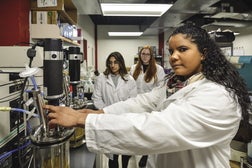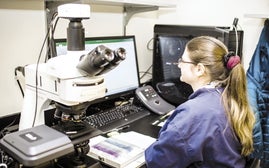Central Mass. needs to be on the mind of Life Sciences Center
Launched in 2008 with much fanfare by the Patrick Administration, the Massachusetts Life Science Center -- a 10-year, $1-billion investment in catalyzing growth in the life science industry in the state -- has achieved some measurable success.
Some seven years later, Massachusetts is an undisputed leader in the life sciences field with 15 of the top 20 global leaders in biopharma having a presence in the state. Who are the clear winners so far after $595 million of the $1 billion has been committed by the Life Sciences Center? Kendall Square in Cambridge has become the hotbed as new development has continued unabated while rents have reached numbingly high levels. Its clearly the place to be, and companies have been more than willing to pay the premium for a Cambridge address.
Second, the state university system has been a direct beneficiary, as some $200 million to date have been allocated to building infrastructure. The largest single grant was $90 million in funding for the $400-million Albert Sherman Center at UMass Medical School, which opened in 2013, bringing the total invested from the Life Sciences Center to Central Massachusetts in to roughly $140 million.
A new administration in the governor’s office has also brought change to the leadership of the Life Science Center as long time director Dr. Susan Windham-Bannister, who left in June, has recently been replaced by Travis McCready, a former executive at the Boston Foundation. Will the remaining funds be gobbled up largely in greater Boston, or can the Central Mass. region, which has much to offer and much to gain from leveraged investments in the life sciences, get its fair share of the pie?
The initial read from McCreary is that the Baker Administration is deliberately looking to spread the wealth and invest the remaining funds throughout the state -- and clearly has Central Mass on its radar. One of the strategies is to leverage the huge presence of biotech leaders already with research facilities in the Boston area to create manufacturing jobs in lower-cost centers throughout the state where there is already a skilled workforce.
Combined with Worcester’s already growing research strength at UMass Medical School, WPI and other academic institutions, the region stands to benefit from both kinds of job growth.
In McCready’s interview with WBJ Digital Editor Sam Bonacci, the new director was very enthusiastic about Central Massachusetts’ prospects at being a life science hub as the state’s initiative moves into its second phase. While we are pleased with the what he is saying, actions -- particularly the kind that send more state money to the region -- always will speak louder than words.
How the remaining $405 million from the original $1 billion dollar promise is spent remains to be seen. Some critics have pointed out that government should not be in the business of picking winners and looser industries, and that incentives for R&D and infrastructure, and tax credits should be offered to a broader base of industries rather than exclusively to the life sciences.
Afterall, growing one industry at the cost of diminished jobs in another key sector can prove to be a zero sum game. However, the Baker administration now seems ready to stay the course with the center, so now it is up to the political, educational and industry leaders from Central Massachusetts to make their strongest case for further investment.
One significant advantage that our region continues to have is a lieutenant governor with strong ties to the region. Worcester’s Tim Murray was involved in the original legislation, and today Shrewsbury’s Karyn Polito remains a strong in watching out for the interests of Worcester and the region.
In addition, a focused legislative delegation needs to help advocate for further leveraging the growth that is happening through Massachusetts Biomedical Initiatives incubator programs, the many related life science programs at the region’s colleges and universities, the recent relocation of GE’s Healthcare Life Sciences division to Marlborough, and more.
Central Mass does not have the concentrated cluster of jobs that the Cambridge area does, but it nonetheless stands to see significant growth from an industry that has already has a strong foothold on the region.
Lets hope the new leadership and renewed focus at the Life Sciences Center add up to real job growth across the state.













0 Comments